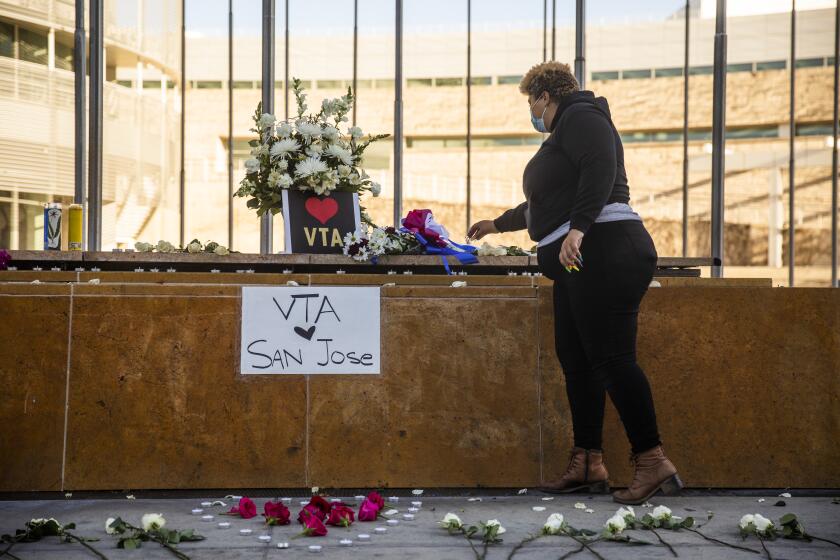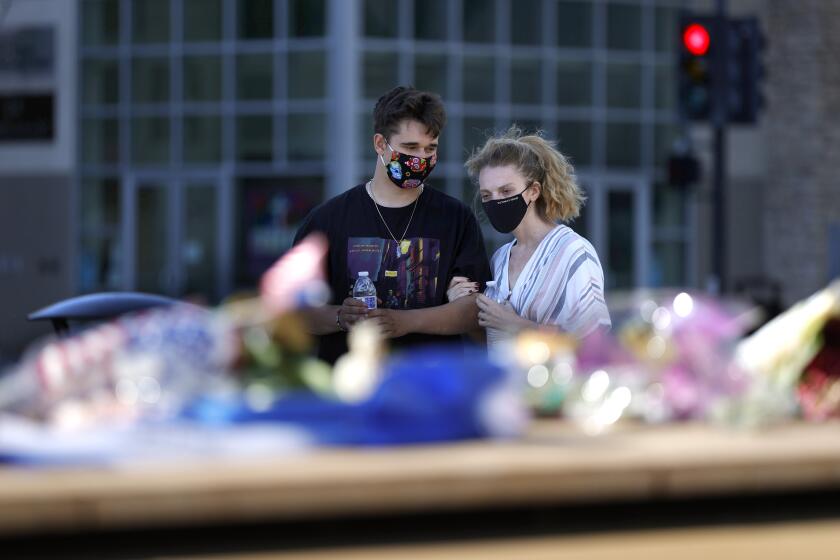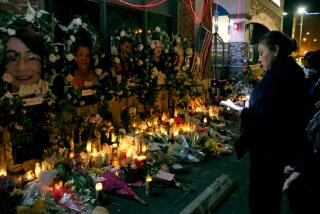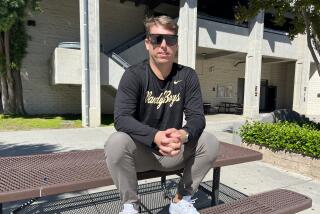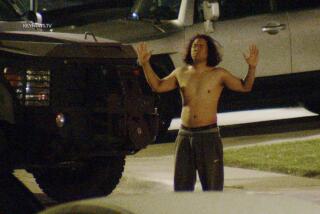San Jose shooter had 12 guns, 25,000 rounds of ammunition at home, sheriff says
- Share via
After a mass shooting left nine workers at a Valley Transportation Authority rail yard in San Jose dead, authorities are trying to understand why — and how — the gunman committed the horrific attack.
Evidence has painted a picture of the assailant, 57-year-old Samuel Cassidy, as a disgruntled VTA worker who hated his job. Authorities on Friday said a search of his house — which was burned in a fire that coincided with Wednesday’s shooting — uncovered multiple cans of gasoline, suspected Molotov cocktails, 12 firearms and approximately 25,000 rounds of various types of ammunition.
“It is clear that this was a planned event and the suspect was prepared to use his firearms to take as many lives as he possibly could had sheriff’s deputies not made entry to stop his rampage,” Santa Clara County sheriff’s spokesman Russell Davis said in a news release.
Emerging reports Friday also indicated that Cassidy may have been facing a disciplinary hearing at the agency, where he worked as a maintenance worker for the last eight years.
But representatives for VTA said he was not scheduled for a disciplinary hearing Wednesday “or any other upcoming or prior date.” He was scheduled to report for a regular shift the day of the shooting.
The VTA is reviewing all records pertaining to Cassidy and whether he made other employees fearful or uneasy, the agency said.

Some who worked with Cassidy described him as a loner.
“Sam was definitely outside the group,” said Kirk Bertolet, 64, a 12-year VTA employee who was on duty at the time of the shooting. “I never once saw him sitting at a table with co-workers talking or doing anything. He was always [by] himself doing something, and never interacted.”
Bertolet said the workplace was composed of blue-collar workers who were sometimes tough on each other.
“Sometimes, if you’re a little thin-skinned, maybe you don’t fit in,” he said.
The nature of the attack was deliberate, methodical and targeted, the investigation has revealed. Witnesses have said Cassidy appeared to pass over some people while selecting others.
“Based on recent developments in the investigation, we can say that the suspect has been a highly disgruntled VTA employee for many years, which may have contributed to why he targeted VTA employees,” Davis said Thursday.
A source at the agency said that Cassidy had “gone off” on managers in the Operations Control Center about three weeks before the shooting when they called on him to perform emergency maintenance work and that he had told them he wouldn’t fix anything until they fixed his paychecks.
The second building where he was headed before encountering sheriff’s deputies housed the Operations Control Center, according to the source.
Victims of the San Jose shooting at a Valley Transportation Authority light rail yard were longtime employees.
Several agencies, including the San Jose police and fire departments, the FBI and the Bureau of Alcohol Tobacco, Firearms and Explosives, were assisting the Santa Clara County Sheriff’s Office with the investigation at the crime scene and at Cassidy’s home on Angmar Court, where a fire ignited just minutes after the shooting began.
Santa Clara County Sheriff Laurie Smith has said Cassidy likely used a detonator device to ignite the fire at the same time as the shooting. The VTA rail yard is eight miles from his home.
“It is believed that the suspect coordinated the destruction of his residence,” sheriff’s officials said Friday. He is believed to have acted alone.
FBI officials on Friday morning confirmed that investigators also found intact Molotov cocktails inside Cassidy’s home and that bomb technicians will be “working to make suspicious materials as safe as necessary so that investigators can continue to collect evidence.”
Erica Ray with the San Jose Fire Department said authorities also located a device at the home that they were going to render safe. Investigators later determined it was an inert box of batteries and wires.
During a news briefing Friday, San Jose Police Department spokesman Steve Aponte described Cassidy’s home as cluttered and said it was a “possible hoarder situation.”
“It was a challenge for our officers to maneuver through,” he said.
Potential explosive materials were also found in Cassidy’s locker at the VTA rail yard in the hours after the shooting. On Friday, officials said they completed their search of the rail yard and found no explosives.
Cassidy, who authorities said took his own life when deputies confronted him, was armed with three semiautomatic 9-millimeter handguns and 32 high-capacity magazines loaded with additional ammunition. Officials said he fired 39 shots.
Security video released by authorities showed Cassidy at the VTA rail yard walking calmly between the two buildings where the victims were shot Wednesday morning.
A VTA clerical worker, who wished to remain anonymous because she was advised not to speak to the media, said the first building houses the ways, power and signal team and the second building includes operations and light rail maintenance.
Based on the first building’s layout and exit locations, she said, the victims would have had “nowhere to go.”
“They didn’t deserve this,” she said through tears. “They were just good guys who loved their families, who just wanted to go to work and go home every day.”
Family members speak at a vigil for the nine people killed in a mass shooting at a San Jose rail yard.
At a vigil Thursday evening, hundreds of people mourned for the victims, who ranged in age from 29 to 63.
They have been identified as Paul Delacruz Megia, 42; Taptejdeep Singh, 36; Adrian Balleza, 29; Jose Dejesus Hernandez III, 35; Timothy Michael Romo, 49; Michael Joseph Rudometkin, 40; Abdolvahab Alaghmandan, 63; Lars Kepler Lane, 63; and Alex Ward Fritch, 49.
Karman Singh recalled how his brother, Taptejdeep, 36, would joke that he looked younger than Singh, despite being six years older.
He often came to Taptejdeep for help, Singh said, describing how his brother “shielded me from responsibilities of this world.”
Whatever trouble he was in, “he was my first call,” Singh said.
Other families described similarly close relationships with the loved ones they lost.
Audrey, the daughter of Timothy Michael Romo, 49, said her dad would often call her his “favorite little girl,” to which she would playfully respond, “I’m your only little girl.”
Romo’s son, Scott, said that his father had been “everything I ever wanted to be as a man.”
“He was my superman, and I’ll never not miss him,” he said.
One victim, 49-year-old Alex Ward Fritch, died in a hospital after the attack. His wife, Terra Fritch, said she was by his side when died.
“We had one of those very special relationships that I think most people just dream of,” she told The Times. “We were never really apart. And if he was somewhere without me, it was definitely noticed. Like, where is the other half?”
The couple was supposed to renew their vows in Hawaii for their 20th wedding anniversary in September.
Fritch loved dirt bikes, tiki bars and “most of all, luckily, he loved me,” she said.
During the vigil, San Jose Mayor Sam Liccardo read the victims’ names, pausing a few seconds before each one. He spoke about how healing would be a long and hard journey for many.
“We’re here to share our pain, we’re here to share our love, to share our support for each other,” he said. “We’re here to express a singular message in our community: We will heal, and we will heal together.”
Victims’ support funds have been set up through Working Partnership USA and the Amalgamated Transit Union.
More to Read
Sign up for Essential California
The most important California stories and recommendations in your inbox every morning.
You may occasionally receive promotional content from the Los Angeles Times.
